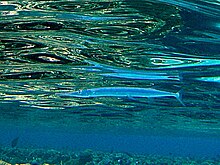
Philibert Commerson, sometimes spelled Commerçon by contemporaries, was a French naturalist, best known for accompanying Louis Antoine de Bougainville on his voyage of circumnavigation in 1766–1769.

Needlefish or long toms are piscivorous fishes primarily associated with very shallow marine habitats or the surface of the open sea. Some genera include species found in marine, brackish, and freshwater environments, while a few genera are confined to freshwater rivers and streams, including Belonion, Potamorrhaphis, and Xenentodon. Needlefish closely resemble North American freshwater gars in being elongated and having long, narrow jaws filled with sharp teeth, and some species of needlefishes are referred to as gars or garfish despite being only distantly related to the true gars. In fact, the name "garfish" was originally used for the needlefish Belone belone in Europe and only later applied to the North American fishes by European settlers during the 18th century.
Sauries are fish of the family Scomberesocidae. There are two genera, each containing two species. The name Scomberesocidae is derived from scomber and the Latin esox meaning pike.
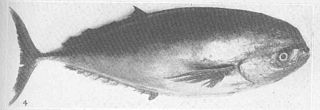
The louvar or luvar is a species of marine ray-finned fish, it is the only extant species in the genus Luvarus and family Luvaridae. This taxon is classified within the suborder Acanthuroidei, which includes the surgeonfish, of the order Acanthuriformes. The juvenile form has a pair of spines near the base of the tail, like the surgeonfish, though they are lost in the adult.
Cololabis is a genus of sauries found in the eastern and northern Pacific Ocean. The name is derived from the Greek word kolos, meaning 'short', and the Latin word labis, meaning 'forceps', referring to the short beak of the type species Scombresox brevirostris.
Tondanichthys kottelati is a species of viviparous halfbeak endemic to Indonesia, where it is only known from Lake Tondano near Mount Tondano in the far north of the island of Sulawesi. It grows to a length of 6.4 centimetres (2.5 in) SL. Despite being a member of the viviparous halfbeak family, this species is believed to be oviparous. This species was described in 1995 by Bruce Baden Collette and its species name honours the Swiss ichthyologist Maurice Kottelat.
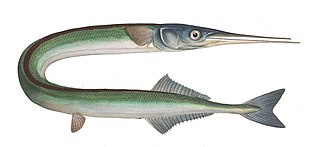
Belone is a genus of needlefish common in brackish and marine waters. It is one of ten genera in the family Belonidae.
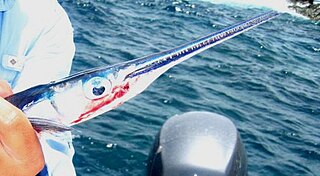
The flat needlefish, or barred longtom, the only known member of the genus Ablennes, is a marine fish of the family Belonidae. Flat needlefish are considered gamefish, frequently caught with the help of artificial lights, but are not often eaten because of their green-colored flesh.
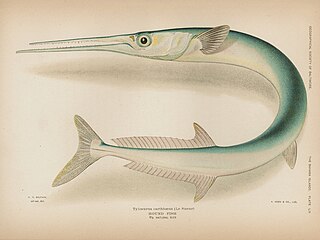
The houndfish is a game fish of the family Belonidae. It is the largest member of its family, growing up to 5 feet (1.5 m) in length and 10 pounds (4.5 kg) in weight. It is also often called the crocodile needlefish.

Prionurus is a genus of marine ray-finned fishes belonging to the family Acanthuridae, the surgeonfishes, unicornfishes and tangs, although some of the species in this genus are called sawtails or doctorfish. The species in this genus are found in the Pacific Ocean with one species, P. biafraensis, found in the Atlantic Ocean.

Strongylura is a genus of needlefishes from the family Belonidae which is distributed throughout the tropical and warmer temperate waters of the world, including some species which live in freshwater.
The short-beaked garfish is an uncommon species of needlefish in marine waters of the eastern Atlantic Ocean. This pelagic needlefish is present off the coasts of Ireland, Spain, Portugal, and the United Kingdom, and possibly in the Mediterranean Sea, as well. This species was thought to be the same as the garfish because they share the same waters. The short-beaked garfish matures at 30 cm (12 in) and can grow to a maximum of 65 cm (26 in) while Belone belone can be 95 cm (38 in). Like all needlefish, this one has an elongated body with beak-like jaws that are lined with razor sharp teeth. The short-beaked garfish's lower jaw is longer than the upper. Its body is silvery like most needlefish and has a black stripe running across its lateral line. The dorsal and anal fins are very close to the caudal peduncle. These fish are oviparous. Eggs may be found attached to objects in the water by tendrils on the egg's surface. These spherical eggs are dispersed on the sea floor (demersal). Not much is known about this fish's feeding habits. It likely preys on small oceangoing fish. It has been caught using mackerel. Needlefish tend to be surface fish, so are preyed upon like Atlantic mackerel, European pilchard, sand smelt, etc. The specific name honours Anatolii Nikolaevich Svetovidov (1903-1985) who was an ichthyologist at the Zoological Institute in Saint Petersburg, Russia and a colleague of N.V. Parin.
Rhynchorhamphus georgii or long-billed halfbeak is a halfbeak of the family Hemiramphidae of the order Beloniformes.
Hyporhamphus yuri is a halfbeak from the family Hemiramphidae which has been reported from Okinawa and nearby islands in the north-west Pacific Ocean. This species was described by Bruce Baden Collette & Nikolai Vasilyevich Parin in 1978 from a type obtained at the Naha Market in Okinawa. The specific name honours the Russian ichthyologist Yuri Nikolayevich Shcherbachev of the Institute of Oceanology, Academy of Sciences of the USSR.

The American halfbeak, also known as Meek's halfbeak, is a halfbeak from the family Hemiramphidae.
Hyporhamphus collettei is a halfbeak from the family Hemiramphidae.

Tylosurus choram, the Red Sea houndfish, is a species of needlefish from the family Belonidae. A marine fish bluish in color with a long slender body, and a pointed long toothed beak, found in most temperate, warm seas, and sometimes rivers, it is found in abundance in the Red Sea. It is a fast predator swimming in small schools near the water surface. Like other species of needlefish this species is oviparous, laying eggs which attach themselves to objects in the water by means of filaments which cover the outer layer of the egg. Tylosurus choram is found in the Red Sea and in coastal waters around the Arabian Peninsula to the Gulf of Oman. It has been reported twice, forty years apart, in the Mediterranean Sea off Israel. This species was described as Belone choram by Eduard Rüppell in 1837 with the type locality given as the Red Sea, the specific name choram is Arabic for needlefish.
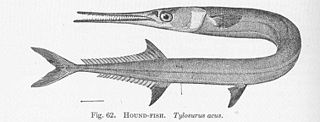
Tylosurus acus is a game fish of the family Belonidae.
Platybelone lovii is a species of needlefish from the family Belonidae. It is a predatory, pelagic fish which is endemic to the eastern Atlantic Ocean in the waters around Cape Verde. This species was described by Albert Günther in 1866 as Belone lovii and was named in honour of the British naturalist Richard Thomas Lowe (1802-1874).

Tylosurus fodiator, the Mexican needlefish, is a species of needlefish from the family Belonidae which is found only in the eastern Pacific, from the Gulf of California south to Ecuador including the Galapagos, Cocos and Malpelo Islands. It was previously considered to be a subspecies of the houndfish but is now regarded as valid species. This species is normally encountered close to the coast but can be found in offshore waters. It is a predatory species, feeding mainly on small fishes. They lay eggs which adhere to objects in the water by filaments which cover the outer layer of the eggs. This species was described in 1882 by David Starr Jordan and Charles Henry Gilbert with the type locality given as Mazatlán in Sinaloa, western Mexico.
